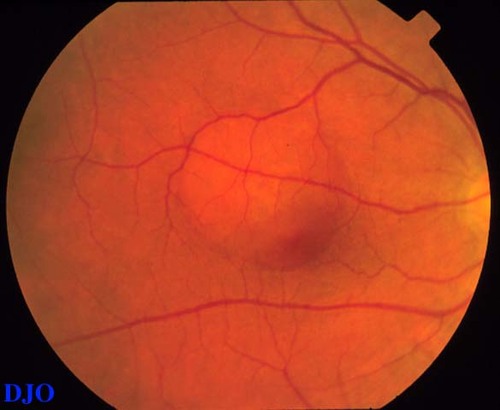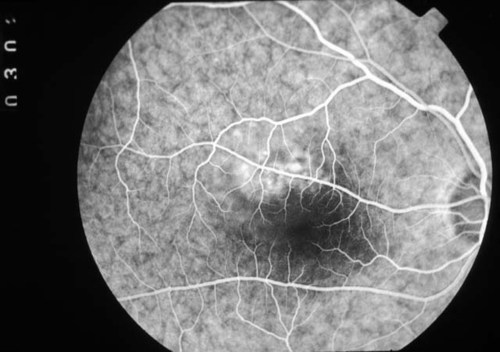|
|
 |
 |
 |
 |
|
|
Retina/Uveitis Quiz 8
|
Printer Friendly
|



Scott Burk, MD/PhD | Massachusetts Eye and Ear Infirmary, Harvard Medical School August 15, 1996
|
|
[Back to Questions] [Back to Retina/Uveitis]
|

Figure 1
Figure 1 shows the right fundus of a 39 year old man who noted a paracentral gray spot and distortion for 2 days in that eye.
|

Figure 2
Figures 2-3. Figures 2 and 3 SHOW the early and late fluoresceins of this patient.
|

Figure 3
|
| Questions and Answers | 1. What is your diagnosis?
Answer: Central serous chorioretinopathy
2. What is the usual age range for this condition?
Answer: 20-45 years.
3. Is there a gender predominance?
Answer: Yes, males are affected 10 times as frequently as females.
4. What is the pathophysiology of this condition?
Answer: There is an idiopathic RPE detachment with fluid leakage INTO the subretinal space resulting in an associated serous retinal detachment. There tends to be some association with type A personality and high stress levels possibly through the action of adrenalin and cortisol, however the etiology of this disease remains unclear.
5. How is fluoroscein angiography helpful?
Answer: Fluorescein identifies the area of RPE detachment and may SHOW leakage INTO the subretinal space.
6. What is the natural history of this condition?
Answer: Most patients do very well, 80-90% spontaneously resorb the subretinal fluid and recover normal visual acuity within 6 months (average time to recovery 4 months). Often, however, there are residua such as metamorphopsia, decreased contrast sensitivity, altered color perception, and even faint scotoma. 40-50% of patients will have one or more recurrences, and a small percentage of patients may develop chronic detachment with persistent loss of vision.
7. How would you treat this patient?
Answer: The usual treatment is observation for at least 4 months. If there was a persistent detachment, a history of previous episodes with permanent visual loss, or an occupational need to regain vision quickly e.g. pilots, then laser photocoagulation at the site of fluorescein leakage has been shown to speed recovery of vision.
| | | [Back to Questions] |
|
 |
 |
 |

|
|
 Welcome, please sign in
Welcome, please sign in  Welcome, please sign in
Welcome, please sign in